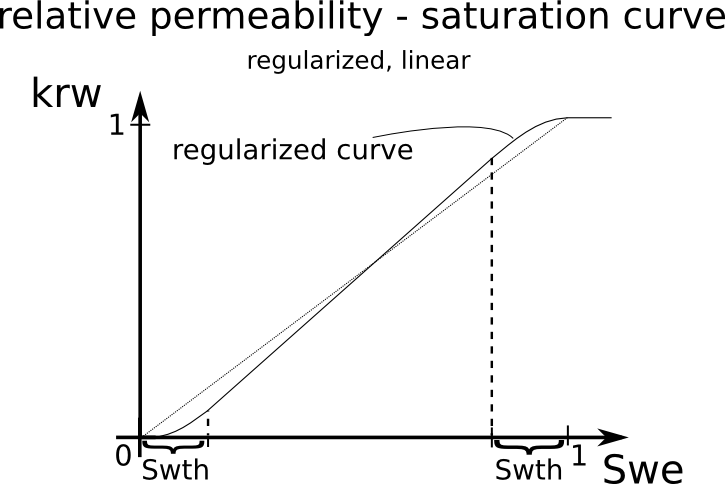Implements a linear saturation-capillary pressure relation. More...
#include <dumux/material/fluidmatrixinteractions/2p/regularizedlinearmaterial.hh>
Implements a linear saturation-capillary pressure relation.
The entry pressure is reached at \(\mathrm{\overline{S}_w = 1}\), the maximum capillary pressure is observed at \(\mathrm{\overline{S}_w = 0}\).
It may seem strange to regularize a linear material, here comes the rationale:
The relative permeabilities are 0 or 1 outside of the range of effective saturation. However, the transition between the linearly changing and the constant part is not smooth but with a kink. The Newton scheme does not like that. Therefore a smooth transition is accomplished by interpolating these regions with a spline.
An example of the regularization of the relative permeability is shown below:

Public Types | |
| using | Params = ParamsT |
| using | Scalar = typename Params::Scalar |
Static Public Member Functions | |
| static Scalar | pc (const Params ¶ms, Scalar swe) |
| The linear capillary pressure-saturation curve. More... | |
| static Scalar | sw (const Params ¶ms, Scalar pc) |
| The saturation-capillary pressure curve. More... | |
| static Scalar | endPointPc (const Params ¶ms) |
| The capillary pressure at Swe = 1.0 also called end point capillary pressure. More... | |
| static Scalar | dpc_dswe (const Params ¶ms, Scalar swe) |
| Returns the partial derivative of the capillary pressure to the effective saturation. More... | |
| static Scalar | dswe_dpc (const Params ¶ms, Scalar pc) |
| Returns the partial derivative of the effective saturation to the capillary pressure. More... | |
| static Scalar | krw (const Params ¶ms, Scalar swe) |
| The relative permeability for the wetting phase. More... | |
| static Scalar | krn (const Params ¶ms, Scalar swe) |
| The relative permeability for the non-wetting phase. More... | |
| using Dumux::RegularizedLinearMaterial< ScalarT, ParamsT >::Params = ParamsT |
| using Dumux::RegularizedLinearMaterial< ScalarT, ParamsT >::Scalar = typename Params::Scalar |
|
inlinestatic |
Returns the partial derivative of the capillary pressure to the effective saturation.
This is equivalent to \(\mathrm{ \frac{\partial p_C}{\partial \overline{S}_w} = - (p_{C,max} - p_{C,min}) }\)
| swe | Effective saturation of the wetting phase \(\mathrm{\overline{S}_w}\) conversion from absolute saturation happened in EffToAbsLaw. |
| params | A container object that is populated with the appropriate coefficients for the respective law. Therefore, in the (problem specific) spatialParameters first, the material law is chosen, and then the params container is constructed accordingly. Afterwards the values are set there, too. |
|
inlinestatic |
Returns the partial derivative of the effective saturation to the capillary pressure.
| pc | Capillary pressure \(\mathrm{p_C}\) in \(\mathrm{[Pa]}\) |
| params | A container object that is populated with the appropriate coefficients for the respective law. Therefore, in the (problem specific) spatialParameters first, the material law is chosen, and then the params container is constructed accordingly. Afterwards the values are set there, too. |
|
inlinestatic |
The capillary pressure at Swe = 1.0 also called end point capillary pressure.
| params | A container object that is populated with the appropriate coefficients for the respective law. Therefore, in the (problem specific) spatialParameters first, the material law is chosen, and then the params container is constructed accordingly. Afterwards the values are set there, too. |
|
inlinestatic |
The relative permeability for the non-wetting phase.
| params | A container object that is populated with the appropriate coefficients for the respective law. Therefore, in the (problem specific) spatialParameters first, the material law is chosen, and then the params container is constructed accordingly. Afterwards the values are set there, too. |
| swe | Effective saturation of the wetting phase \(\mathrm{\overline{S}_w}\) conversion from absolute saturation happened in EffToAbsLaw. |
|
inlinestatic |
The relative permeability for the wetting phase.
| params | A container object that is populated with the appropriate coefficients for the respective law. Therefore, in the (problem specific) spatialParameters first, the material law is chosen, and then the params container is constructed accordingly. Afterwards the values are set there, too. |
| swe | Effective saturation of the wetting phase \(\mathrm{\overline{S}_w}\) conversion from absolute saturation happened in EffToAbsLaw. |
|
inlinestatic |
The linear capillary pressure-saturation curve.
This material law is linear: \(\\mathrm{ p_C = (1 - \overline{S}_w) (p_{C,max} - p_{C,entry}) + p_{C,entry} }\)
| swe | Effective saturation of the wetting phase \(\mathrm{\overline{S}_w}\) conversion from absolute saturation happened in EffToAbsLaw. |
| params | A container object that is populated with the appropriate coefficients for the respective law. Therefore, in the (problem specific) spatialParameters first, the material law is chosen, and then the params container is constructed accordingly. Afterwards the values are set there, too. |
|
inlinestatic |
The saturation-capillary pressure curve.
This is the inverse of the capillary pressure-saturation curve: \(\mathrm{ S_w = 1 - \frac{p_C - p_{C,entry}}{p_{C,max} - p_{C,entry}} }\)
| pc | Capillary pressure \(\mathrm{p_C}\) in \(\mathrm{[Pa]}\) |
| params | A container object that is populated with the appropriate coefficients for the respective law. Therefore, in the (problem specific) spatialParameters first, the material law is chosen, and then the params container is constructed accordingly. Afterwards the values are set there, too. |